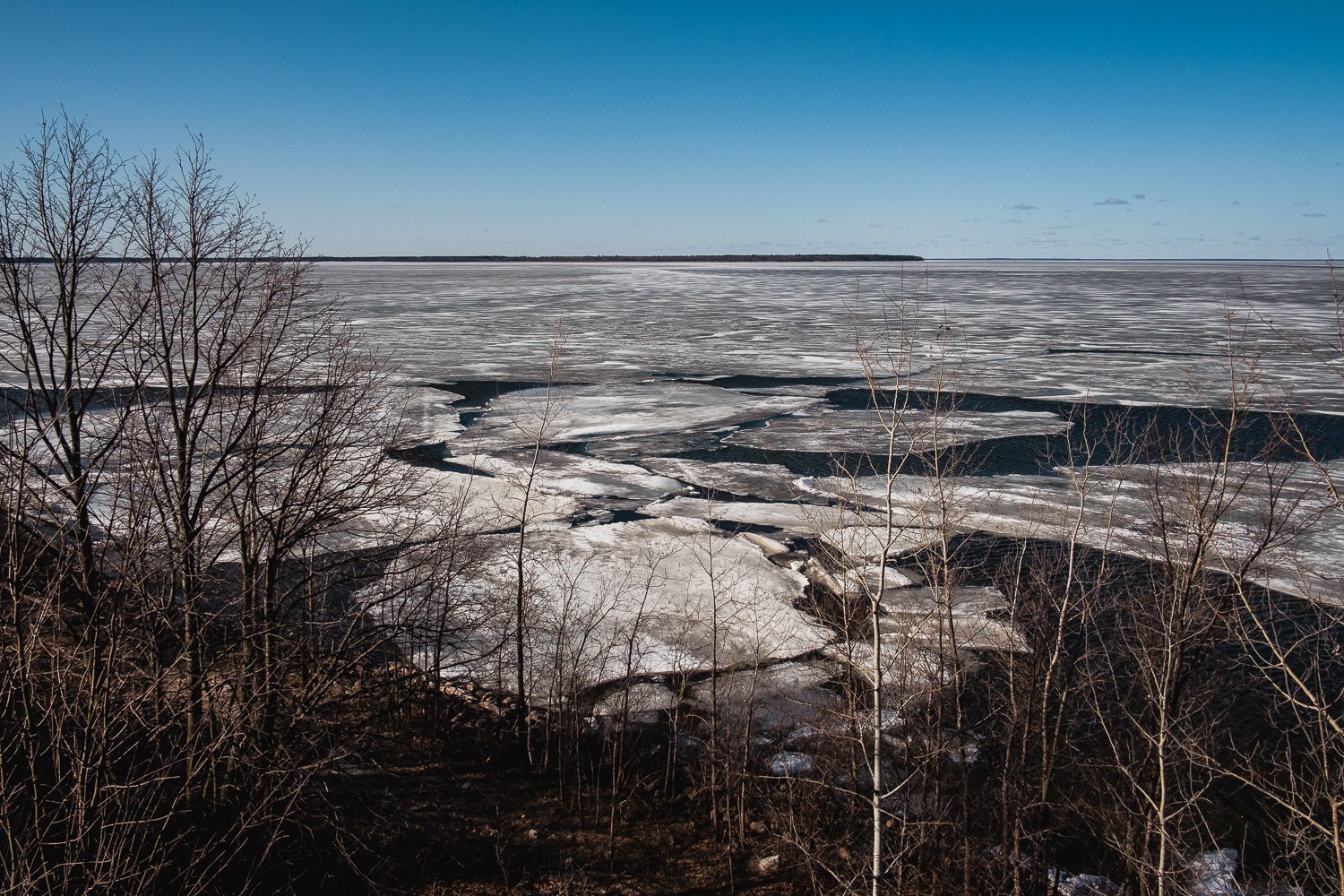Walleye anglers, curious about the progress of the ice breaking up on Lake Winnie may have had a few anxious moments this spring. But, compared to last year’s “ice-out cliff hanger”, this is going to be a walk in the park. Today’s images of Cutfoot and Winnibigoshish compared to those we viewed around the same time in 2022 indicate that we’re 4 to 5 days ahead of where we were last spring. Admittedly, this still constitutes a later than typical ice-out, but at least we have a little bit of wiggle room to work with.
Bowens Flats Lake Winnibigoshish May 1, 2023
One of this week’s top news items is whether the MN DNR will set up gear for the walleye egg take at Little Cutfoot Sioux. As of Monday 5-1-23, the current working plan was to set up and collect eggs to be taken into the Grand Rapids hatchery. For that to happen, Little Cutfoot would have to be ice-free by later today, or Wednesday at the latest. Then oxygen monitoring would determine the start date for walleye trapping. With brisk breezes and choppy water, dissolved oxygen could reach desirable levels in 3 to days. Following that timeline, even the most optimistic schedule would place fisheries staff at the traps sometime next weekend.
During that time, assessing catch rates from some of the other regional egg takes will determine whether Grand Rapids can meet the 2023 quota by receiving eggs from other areas. Area egg take operations that have opened already are off to a strong start. So, early indications are that the Grand Rapids operation at Little Cutfoot would be short and fast if it happens at all.
Either way, the 2023 walleye season is going to happen on schedule, and we’ll be ready!
This year, we’re anticipating a continuation of the strong angler catch rates we enjoyed in both 2021 and 2022. The 2 back-to-back, “dynamo year classes” of walleyes from 2018 and 2019 will continue to dominate the population. This summer, the size structure of walleyes from both years will be very desirable. Many of the fish from the 2018-year class will range between 16 and 18 inches and by summer’s end, there will be a significant number exceeding 18 inches.
Walleyes from the 2019-year class, many now ranging from 14 to 15 inches, will also be desirable for folks interested in a family fish fry. This ultra-strong year class will grow throughout the summer too and before fall, will provide anglers with lots of opportunity for both quality and quantity.
Walleyes from the strong 2013-year class reached maturity in the 2016-2017 seasons and many of them are still swimming in Winnie. Folks interested in catching larger fish for a “photo op” will continue to have a great opportunity to achieve that goal too.
As always, we’ll be encouraging folks to be selective, targeting fish that are most likely to be males. Female walleyes tend to be larger than their male counterparts of the same age. So, it makes sense to get familiar with the average sizes of each year’s class and when possible, select fish in the smaller range for harvest. We will be in close contact with DNR fisheries staff and will provide frequent updates about growth rates during the season.
As happy as we are about having strong walleye populations in Cutfoot Sioux and Winnie, they may be contributing, at least in part, to an overall decline in populations of Yellow Perch.
All those hungry walleye mouths to feed could be responsible, in part, for lower-than-average perch numbers in Winnie and Cutfoot. At 3.3 fish per net, the fall survey recorded the lowest number of Yellow Perch in recent history. The decline appears to be in the most recent year classes, affecting fish of the smallest sizes.
As is often the case though, lower numbers of fish have resulted in more anglers catching perch of greater quality size. In 2021, 25% of perch recorded in angler surveys were over 9 inches. Fall fishing produced good numbers of quality fish, often mixed in with walleyes. Over the past winter, we observed firsthand, anglers with good catches of fish in the 10-to-11-inch range, with an occasional 12-inch bonus.
Perch enthusiasts fishing the lake this summer will be well advised to cover lots of water, checking a variety of habitats. Perch, like most fish are highly adaptable and can be found feeding on anything. Crawfish, minnows, insects and young of the year gamefish are all on the menu. Habitat like gravel bars, weed beds and semi-soft, marl are likely feeding territory and could be found both shallow and deep.
Northern Pike, another popular species with anglers, are well suited for Winnibigoshish and connected waters. The protected 22-to-26-inch slot appears to be having a positive impact on size structure. It’s too early to prove statistically, but anglers on the lake do report catching more pike of larger average sizes. The trade-off is that catch rates of smaller pike have declined.
Most folks would take declines in small pike as positive news, and DNR fisheries staff agree. “That was the point of instituting the 22–26-inch protected slot”, said retired DNR Large Lake Specialist Gerry Albert. “Obviously, pike sizes tend to improve simply by protecting larger ones with a slot limit and keeping more of them in the lake. But there are other less obvious reasons that lower populations can be desirable. Less competition for forage, more space for fish to grow can be helpful too.”
It’s not clear if the protected slot limit is responsible for the change, but we’ve also seen more anglers catching fish within the protected slot sizes but have also noted more fish over 26 inches being caught too. Anecdotally, we see evidence that folks have an excellent chance of catching some “photo op” pike in the 26-to-30-inch range.
Panfish are important to our guests, especially during summer and fall. If you hadn’t already heard, Cutfoot Sioux made the list of lakes to receive protection under the “Quality Sunfish initiative.” The initiative, widely accepted by anglers, is aimed at helping restore larger panfish into systems where heavy harvest pressure has occurred. Also anecdotally, sunfish numbers throughout the Cutfoot system appear to have rebounded. We have noted though that many of them had not achieved larger sizes. Like the pike regulation, it is too soon to assess the impact on the size structure of sunfish. But assuming our lakes follow the trajectory of other lakes that have these protections, the future of sunfish here could well be a happy one. So, for our guests, the 5 sunfish daily limit could be an exciting development, we’ll know more as time goes on, but we’re hopeful.
Crappie populations everywhere in the region had been declining for a few years. Lake Winnie and Cutfoot Sioux were not exempt, catch rates for our guests have been lower than average recently. During 2022, there was an apparent year class of young ‘up-and-comers”. Crappies in the 5-to-7-inch size range were showing up not just in Cutfoot and Winnie, but in dozens of north central Minnesota lakes. We’re hopeful that the next couple of seasons will bring these fish to maturity and we’ll be updating the progress every chance we get.
Like you, the timing of this year’s ice out had us a little anxious for a while. But it is settled now, and our attention has turned toward getting the cabins, lodge and grounds ready for the fishing opener. We’re looking forward to seeing everybody and we’re grateful for another season.
We’ll be keeping you posted all season long, so be sure to check in often.




